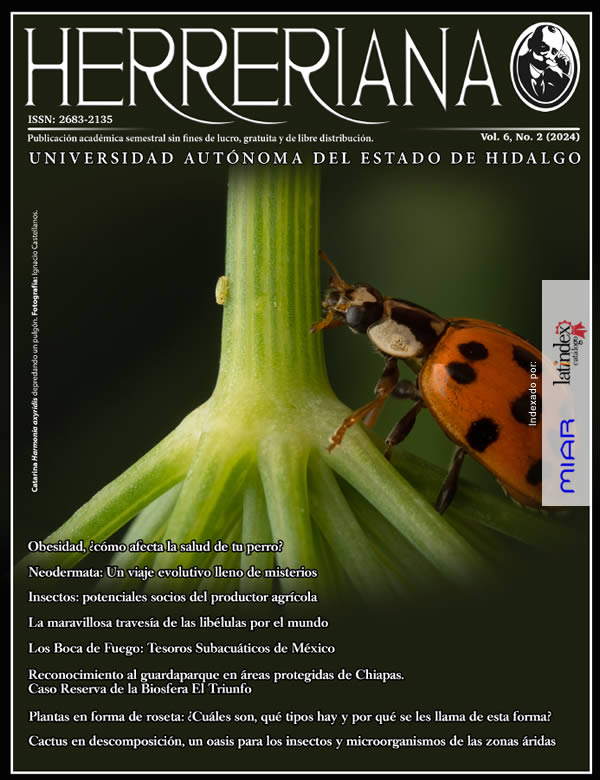Obesity, how does it affect your dogs health?
Abstract
Obesity is a chronic disease that affects the domestic dog and according to recent studies its frequency is increasing worldwide. Several aspects are involved in its development, such as: age, sex, genetics, the nutritional content of the food provided, the time of daily physical activity and the environmental conditions in which the dog lives. This disease is characterized by the progressive accumulation of fatty tissue (adipose tissue) in the body that eventually causes disease, affecting the cardiovascular, musculoskeletal, immune, gastrointestinal, reproductive and nervous systems. The treatment of this disease requires the attention of veterinary medicine professionals.
Downloads
References
Aluja, Aline S. de. 2011. Bienestar animal en la enseñanza de Medicina Veterinaria y Zootecnia: ¿Por qué y para qué?. Veterinaria México, 42(2), 137-147. http://www.scielo.org.mx/scielo.php?script=sci_arttext&pid=S0301-50922011000200004&lng=es&tlng=es
Álvarez J, Fernández RJM, Guarner F, Gueimonde M, Rodríguez JM, Saenz de Pipaon M. y Sanz Y. 2021. Microbiota intestinal y salud. Gastroenterología y Hepatología, 44, (7): 519-535.
Bagheri, Soghra, Samaneh Zolghadri, and Agata Stanek. 2022. "Beneficial Effects of Anti-Inflammatory Diet in Modulating Gut Microbiota and Controlling Obesity". Nutrients. 14, no. 19: 3985. https://doi.org/10.3390/nu14193985
Cortese L, Terrazzano G. and Pelagalli A. 2019. Leptin and Immunological Profile in Obesity and Its Associated Diseases in Dogs. Int J Mol Sci. 14;20(10):2392. doi: 10.3390/ijms20102392
Elosua-Bayés I and Beloqui Ruiz Ó. 2020. Association between non alcoholic fatty liver disease, metabolic and vascular risk. Clin Investig Arterioscler. 32(5):200-205. English, Spanish. doi: 10.1016/j.arteri.2020.04.002.
González Domínguez, M. S. y Bernal, L. 2011. Diagnóstico y manejo de la obesidad en perros: una revisión.Revista CES Medicina Veterinaria y Zootecnia, 6(2),91-102.[fecha de Consulta 14 de Febrero de 2024]. https://www.redalyc.org/articulo.oa?id=321428106008
Mejía Huerta, Nancy Guadalupe, Córdova Izquierdo, Alejandro, Aragón Hernández, Jesús, Flores Pérez, Fernando Iván. y Pérez-Martínez, Mario. 2015. Histomorphology of Liver, Testicle and Body Fat in Farm Rabbits Fed with an Obesogenic Diet During the Peripuberal Period. International Journal of Morphology, 33(4), 1371-1376. https://dx.doi.org/10.4067/S0717-95022015000400030
O'Neill DG, Sahota J, Brodbelt DC, Church DB, Packer RMA. And Pegram C. 2022. Health of Pug dogs in the UK: disorder predispositions and protections. Canine Med Genet. 18;9(1):4. doi: 10.1186/s40575-022-00117-6.
Segami C, Lia, Dávila F, Roberto, y Lira M, Boris. 2021. Factores asociados a la obesidad en perros adultos de Lima, Perú. Revista de Investigaciones Veterinarias del Perú, 32(3), e20399. https://dx.doi.org/10.15381/rivep.v32i3.20399
Suárez-Carmona, Walter, Sánchez-Oliver, Antonio Jesús, y González-Jurado, José Antonio. 2017. Fisiopatología de la obesidad: Perspectiva actual. Revista chilena de nutrición, 44(3), 226-233. https://dx.doi.org/10.4067/s0717-75182017000300226
Zhang XJ, Chinkes DL, Aarsland A, Herndon DN. and Wolfe RR. 2008. Lipid metabolism in diet-induced obese rabbits is similar to that of obese humans. J Nutr. 138(3):515-8. doi: 10.1093/jn/138.3.515.
Copyright (c) 2024 Mario Pérez Martínez

This work is licensed under a Creative Commons Attribution-NonCommercial-NoDerivatives 4.0 International License.










